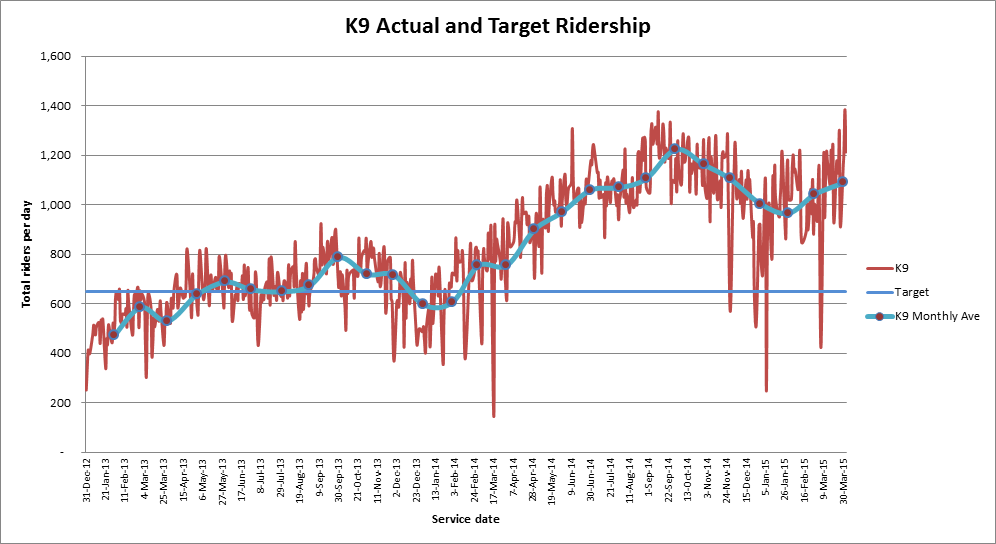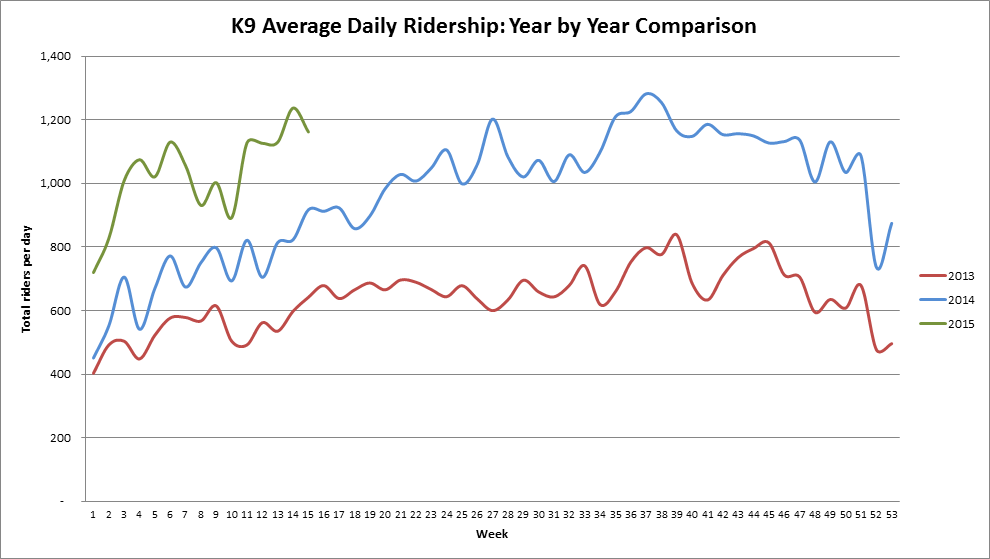The K9 MetroExtra Bus Route Surpassing Expectations
Two years and 500,000 riders later, the K9 continues to demonstrates the benefits of MetroExtra limited-stop bus service.
At the end of this month, the K9 bus route will pass an important milestone – it will carry its half-millionth rider. Since its inaugural run, the K9 has continually surpassed all of our expectations.
The concept for the K9 emerged from a year long study on bus service needs in the New Hampshire corridor and on New Year’s Eve 2012, Metro launched the K9 service – the first limited-stop bus service introduced in Maryland in many years. The K9 provided faster and more reliable service along New Hampshire Avenue between Fort Totten Metrorail station and the Northwest Park apartments in Montgomery County. Riders responded enthusiastically, pushing the K9 over its 6-month target of 650 daily riders in less than four months. In March 2014, we extended the route north to the Federal Research Center in White Oak to coincide with the transfer of several thousand FDA employees to that facility and increased the service frequency to every 15 minutes. Ridership surged again, passing 1,000 daily riders for first time only a week later. Two months later daily ridership was up another 20% to 1,200 daily riders.
Ridership on the K9 has grown an astonishing 50% year-over year for the past two years in a row, and this growth has not come at the expense of ridership on the underlying K6 local bus service (the K6 grew 2% between 2013 and 2014 and has been virtually flat for 2015). Instead, the K9 has tapped into pent-up demand for transit service within the corridor by providing desperately needed capacity.
So what’s next for the K9? When both capital and operating funding is available, Metro plans to extend the K9 to the White Oak Transit Center. While this extension is only a short distance up New Hampshire Avenue from the FDA, it would require an additional bus to maintain the current 15 minute frequency. This requires a capital investment in a new bus (about $750,000) as well as additional funds to pay for the operation and maintenance of the bus (about $150,000 annually). However, this extension would provide benefits to the hundreds of riders traveling to and from White Oak, not just on the K6, but on the overcrowded Z6 and Z8 as well.
In addition to the extension to White Oak, Metro will continue to work closely with Montgomery County, Prince George’s County, the City of Takoma Park, the Maryland Department of Transportation and State Highway Administration, and the District Department of Transportation to improve travel times and the overall travel experience for customers. This includes dedicated bus lanes, transit signal priority, signal re-timing, as well as new payment options, real-time bus arrival displays, and improved and fully accessible bus stops and shelters. As more premium bus features are added to the K9 service, we hope to continue to grow the market and demand for bus transit in the corridor and ultimately evolve the K9 to deliver the type of service envisioned in Montgomery County’s bus rapid transit vision for the New Hampshire corridor.
Replicating the Experience? The New Hampshire Avenue corridor is not alone in the demand for additional service. Other high-ridership lines in Maryland look similar to where New Hampshire Avenue corridor was a few years ago. The C line along University Boulevard, F line between Silver Spring and New Carrollton, Q line along Viers Mill Road, Y line along Georgia Avenue, and Z line along Colesville Road/Columbia Pike all experience significant overcrowding problems. Metro has plans prepared to introduce MetroExtra service in each of these corridors — once funding is available. We would fully expect to see a similar response from riders to MetroExtra service in those corridors as we have seen on New Hampshire Avenue.
| Customer testimonials:“I just wanted to say thank you for bringing the K9 to one of the most heavily bus routes from MD to DC. I love riding the bus. It is quick on time and the drivers are not stressed out and always courteous… Please keep the K9 and extend to white oak! Thank you again.”“Thank you for implementing the K9 bus route. It is unequivocally the best thing that has happened to my morning commute since the invention of coffee, placing it solidly in the top five behind other innovations such as the wheel, and engines. The K9 is fast, typically not very crowded, and the drivers are a little more cheerful than the K6 drivers. The buses are also newer. This addition has made my commute a little bit faster and more pleasant. Thank you very much for creating the new limited-stop route. I very much appreciate the service, and the drivers.”“The new K9 is so fast and convenient! I love it! I haven’t been on the K6 since the K9 service started. I remember that Metro did a survey on the K6 a few years ago and it’s great to see that Metro was really listening to riders.” |




Further improvements and BRT cannot come fast enough on this route. Should have happened years ago when the idiotic decision to put 10,000 FDA employees in an isolated suburban office park was made.
The area would see a massive surge in bike-ridership too if improvements were made so that bikers did not have to risk their life to ride to the FDA.
I hope funding can be found soon for expanding service in each of the above identified corridors. They’re almost all BRT corridors identified in the Montgomery County BRT plan and I think getting the MetroExtra service started now is a great starting point to eventual corridor improvements. So many of the people on the Z, Y and Q lines are traveling long distances and are forced to stop at every local stop along the line. I bet the demand for these limit stop buses may be high enough to reallocate some of the ‘local’ buses to run the limited stop routes.
Great to read of the success of the K9. In a period of highly constrained resources for WMATA, the solution should be to transfer service from the local K6 route to the K9. The 10 minute K6 frequency could be reduced to a 12 minute headway (assuming this still allows it to meet loading guidelines) and the K9 could drop from a 15 minute headway to say a 12 minute headway or you could extend the K9 route. Improvements to the headway of the K9 will continue to pull customers off of the K6. That’s the general experience with the 70 and 79 Limited on Georgia Ave. in the District.
WMATA should recognize the popularity of Limited-Stop routes with customers and introduce them more aggressively.
What’s the status of the plans for extension of the K9 to the White Oak Transit Center?
The proposal to extend route K9 to White Oak is currently on hold. Metro will coordinate the K9 service expansion with Montgomery County’s overall BRT plan for the US 29 corridor.
Montgomery County has $11.5 million dollars for speculative BRT work but can’t find 150k a year for such a modest yet beneficial extension? Next thing you know, they won’t implement the much-needed C9 MetroExtra bus service, even though the C2, C4 lines are consistently the most used Metrobus route in all of Maryland. East County always gets shafted.
It’s too bad Montgomery County is blocking the K9 from expanding. They obviously don’t care about the transit users in White Oak. It’s been 3 years now that they’ve been blocking this and there are many of us in White Oak that need the K9 to be extended. Are they afraid that FDA won’t approve of other people riding it?
My sense is that certain Montgomery County officials would rather pursue their speculative dreams of BRT rather than improve service for existing bus lines and existing bus riders. I don’t think FDA has much sway on these matters or much cares if other people ride the bus as long as it doesn’t become completely overcrowded. After all, anyone currently can and does ride the bus from Fort Totten up and down New Hampshire.